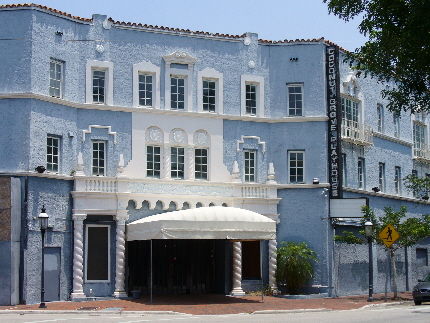
By Bill Hirschman
The Miami-Dade County plan to resurrect the iconic Coconut Grove Playhouse once again suffered a setback Thursday when the Miami City Commission failed to override its mayor’s veto.
But County Mayor Carlos Gimenez said last Friday and his top cultural official Michael Spring reiterated Saturday that they were “prepared” to sue the city to challenge the veto on an array of technical and legal grounds.
The motion needed four of five votes to override Mayor Francis Suarez’s veto which he announced last Friday. But Thursday’s override attempt mirrored the 3-2 tally that the commission produced in its May 9 vote supporting the county project. In fact, Commissioner Wilfredo Gort said with a sigh before his vote to override the veto, “This is going to court. All this… we are just creating a record.”
The three-hour meeting Thursday was supposed to focus solely on complex legal wrangling reflected in Suarez’s veto message and Gimenez’s written rebuttal released Wednesday.
But more than two hours consisted of about 50 evenly divided speakers passionately rehashing their aesthetic arguments most had made in repeated hearings. Those were concepts that the commission technically could not consider Thursday in their consideration of the legal issues arising from the rationales cited in the mayor’s veto message.
Partisans on both sides believe that the other has violated state or federal standards — or legal procedures or guidelines — supporting their belief that the opposition has no defensible arguments. A linchpin issue is whether the city preservation board did or did not, intentionally or unintentionally, previously approved the county plan that contained demolishing the interior of the building. Another is whether that demolition violates state or federal preservation guidelines for a property on the state and federal register of historic places.
The confusion was underscored in the public comment section Thursday in which many ordinary residents on both sides made contentions or assumptions that simply were not true. Good faith misinformation, misstatements and misunderstandings ran rampant.
Even the main players could not agree on crucial issues such as whether demolishing the interior and back walls of the structure would endanger its status on the National Register of Historic Places.
At stake is a joint proposal by Miami-Dade County, Florida International University and the GableStage regional theater. The plan would maintain the iconic front exterior of the 1926 structure but tear down the rest of the deteriorating former movie house. It would be replaced with a modern structure including a 300-seat theater at 3500 Main Highway in Coral Gables. FIU would hold theater classes inside. The city’s parking authority has agreed to pay for and build an adjacent parking garage; some of its proceeds would underwrite the theater’s operational budget. The county and FIU have a lease with the state Department of Environmental Protection which actually owns the property.
That $23.6 million plan, financed mostly with earmarked bond issues proceeds, is ready to go out for bids pending city building permits. But a less advanced competing proposal favored by historical preservationists and a wealthy arts advocate suggests restoring the entire building, featuring a 700-seat theater and a possible price tag of $46 million.
The nationally-known Playhouse has been closed since 2006 – its 50th anniversary season — when an estimated $4 million in debts caused its non-profit board to shutter operations. But arts and county officials led by Gimenez and Spring, director of the Department of Cultural Affairs, had been striving for years before that to preserve some kind of theater operation on the site.
On Thursday, Gort, Manolo Reyes and Joe Carollo voted in favor of an override; Deon Hardemon and Chairman Ken Russell, who represents the district, voted against an override. Hardemon and Russell did not explain their reasoning. The other three expressed strong support for some kind of theater facility and frustration that it had not come to fruition yet.
Suarez had asked Gimenez last Friday to discuss a compromise vision, but they could not find common ground. But at Thursday’s meeting, Gimenez did say for the first time that he was not opposed to building a larger theater if someone would provide the additional expense.
The county proposal has been embroiled for years in a tumultuous and protracted fight that has encompassed fund-raising, polls, contradicting studies, contracts with consultants, public hearings, rallies and copious impassioned social media posts.
The opposition to the county’s proposal fell into two main groups:
—One group, loosely connected under the organizational banner Save The Coconut Grove Playhouse, wants to preserve every aspect of what they contend is an architectural landmark. The building was formally recognized as a “historic site” by the City of Miami in 2005 and more recently was placed on the National Register of Historic Sites.
The supporters of a larger venue yearn for it to be the gem in Miami’s ongoing campaign to become an international center for the arts. They believe that based on the Playhouse’s past, a well-managed venue operating year-round and attracting A-list talents could be a fiscal and artistic success.
But local theater professionals and some national consultants doubt that a larger theater can be self-supporting, even with grants and donations.
The three-story edifice was designed as a silent movie house in 1926 in the Spanish Baroque “Mediterranean Revival” style by Kiehnel and Elliott Architects, and reworked slightly when a hurricane damaged it soon after. Unlike many movie palaces of the era such as the Fox Theater in Atlanta, the interior was not unusually ornate. The application for preservation status called it “a noteworthy expression of the Florida Land Boom” whose “original design by the critically important architectural firm of Kiehnel and Elliott…. embodies the metaphoric Boom and Bust cycles that Florida has experienced, and continue as a signature building reflecting the heyday of Coconut Grove.” But county officials documented that it had been extensively altered inside and out since then.









 A PaperStreet Web Design
A PaperStreet Web Design
